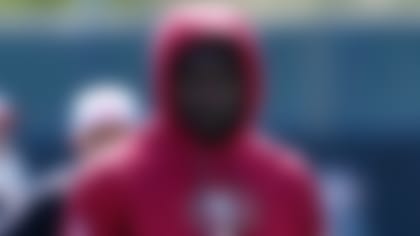Even though NFL scouts and coaches will tell you that the 40-yard dash is overhyped as a player evaluation tool, wide receiver is one position in which pure straight-line speed can be crucial.
Big plays in the passing game are becoming more common -- 12 receivers averaged at least 17 yards a catch in 2011, up from eight in 2010 and more than double the average of 5.4 over the previous decade. This means big, fast wide receivers will be more coveted in this year's draft than they have in the past. But they aren't the only ones benefitting from the NFL's offensive explosion ...
NFL.com's Mock Draft Central
With the combine now in the rearview, NFL.com analysts unveil their attempts at projecting how Round 1 will go on April 26. **More ...**
New England's Rob Gronkowski and New Orleans' Jimmy Graham enjoyed two of the most productive seasons ever at the tight end position, finishing in the top 10 in the league in catches, receiving yards and receiving touchdowns (Gronkowski posted an NFL-high 17). Meanwhile, Brandon Pettigrew (Detroit), Tony Gonzalez (Atlanta), Aaron Hernandez (New England) and Jason Witten (Dallas) all ranked in the top 20 in receptions.
The mismatches these tight ends create in the middle of the field make them the knight to vertical receivers' rook on the gridiron chess board.
Several receivers and tight ends made an impression at last month's NFL Scouting Combine -- some with the long speed needed to blow the top of a defense and others with short-area quickness to routinely move the chains in short or moderate down-and-distance situations.
Wide receivers
Michael Floyd, Notre Dame: With Oklahoma State's Justin Blackmon choosing not to run at the combine with a tender hamstring and Baylor's Kendall Wright putting up disappointing times in the 40-yard dash, Floyd took advantage of the open stage. Most scouts will tell you he doesn't play as fast as his 4.47 40, but the fact he broke the 4.5-second barrier makes it difficult for teams to consider him just a possession receiver. If Notre Dame's all-time leading receiver can convince general managers that his off-field issues are behind him, and if Blackmon runs poorly at his pro day, the difference in grades between those top two receivers will be quite slim.
Draft projection: First round.
Brooks: Who is this guy?
Stephen Hill was overlooked in college, but he put on a show at the combine. Bucky Brooks assesses the rising draft prospect. **More ...**
Stephen Hill, Georgia Tech: Hill may have been the biggest "winner" on the offensive side of the ball at this year's combine, running a blazing 4.36 40 at 6-foot-4, 215 pounds. He also tied for first among all combine participants with an 11-foot-1 broad jump, tied for fifth with a 39-inch vertical and did a fine job running routes and catching passes in drills. He did finish last among receivers with a 4.48 short shuttle, but scouts will remember that Kenny Britt and Marques Colston had similar numbers in their combine workouts. Scouts are more worried about his learning curve and lack of receiving experience in Georgia Tech's option offense (he only had 14 receptions over the Yellow Jackets' last nine games of 2011), but the speed/size combo make him too intriguing a vertical threat to last beyond the top 40 selections.
Draft projection: Late-first/early-second round.
Tommy Streeter, Miami: Like Hill, Streeter burst onto the national scene as a play-making junior (17.6 yards per catch, eight touchdowns). He also had an excellent combine, even though fewer people are discussing his impressive 6-4 7/8, 219-pound frame, huge 10 3/4-inch hands and impressive 4.40 40. Streeter's potential to take the top off an NFL defense won't be ignored, though, likely earning him a second-round selection by a team requiring that sort of threat to complement its smaller, quicker receivers. If Chicago or San Francisco doesn't pick Floyd or Hill in the first round, they could look to get Streeter in the second.
Draft projection: Second round.
Junior Hemingway, Michigan: Michigan's leading receiver in 2011 put together one of the best under-the-radar performances of the combine. Despite measuring at 6-0 7/8, 225 pounds, he ran a respectable 4.53 40 and led all receivers (even the ones coming in 40 pounds lighter) in the short-area agility drills with a 3.98 20-yard shuttle and a 6.59 three-cone. Showing that sort of agility at 225 pounds is something scouts won't forget, and his strong performance all week at the East-West Shrine Game had already heightened teams' awareness of his next-level promise.
Draft projection: Fourth round.
Danny Coale, Virginia Tech: Coale couldn't pass teammate Jarrett Boykin on Virginia Tech's all-time receiving record lists, but he'll likely be rated ahead of his teammate on most draft boards. His combine confirmed some things scouts knew, but the general college football world may not have: He's not that short (5-11 7/8), he's not slow (4.50 40) and he is, indeed, quick in short areas (6.69 three-cone). Coale's hands are strong, and it certainly doesn't hurt that he could contribute on special teams as a punt and kick returner -- and even as an emergency punter (he had a 43.5-yard average on 13 punts in 2011).
Draft projection: Fifth round.
Tight ends
Casserly: Spring spotlight
We're in the "fine tuning" portion of draft evaluation. Charley Casserly identifies 10 prospects with pivotal pro days. **More ...**
James Hanna, Oklahoma: Despite being a converted wide receiver, Hanna was not heavy utilized in Oklahoma's offense (he eclipsed 50 yards receiving in just two games last season). The athleticism he showed at the combine, however, will have teams scrambling for the tape. At nearly 6-3 3/4, 252 pounds, he ran a 4.49 40, benched 225 pounds 24 times and put up receiver-like numbers in his jumps and short-area agility tests. Hanna might not be a dominant in-line blocker or elite receiving prospect, but his somewhat surprising size and athleticism could entice a team to select him early on Draft Saturday as an intriguing tight end prospect who can work off outside receivers.
Draft projection: Fourth/fifth round.
Drake Dunsmore, Northwestern: The Wildcats referred to Dunsmore as their "Superback," lining him up all over the field to take advantage of his versatility. The first-team All-Big Ten tight end ran a solid 4.64 40 while also recording the quickest short shuttle (4.03) and three-cone (6.73) times of all tight ends. Those numbers could remind scouts of another former Big Ten tight end: Owen Daniels, who has become a valued contributor in the passing game for the Houston Texans.
Draft projection: Fourth/fifth round.
Follow Chad Reuter on Twitter @ChadReuter




